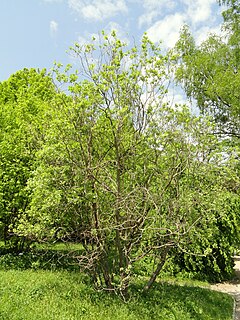
Lepechinia fragrans is a flowering herbaceous shrub known by the common names island pitchersage and fragrant pitchersage. It is a member of the Lamiaceae, or mint family, but like other Lepechinia, the flowers are borne in racemes instead of in mintlike whorls.

Bougainvillea glabra, the lesser bougainvillea or paperflower, is the most common species of bougainvillea used for bonsai. The epithet 'glabra' comes from Latin and means "bald".

Puya mirabilis is a species of Bromeliad in the genus Puya. This species is native to Bolivia.

Felicia fruticosa is a strongly branching shrub of up to 1.3 metres high that is assigned to the daisy family with flower heads consisting of about twenty purple to white ray florets encircling many yellow disc florets, and small flat, entire and hairless leathery leaves. Two subspecies are recognized. Felicia fruticosa subsp. brevipedunculata, from the Limpopo Province of South Africa is up to 1.3 metres tall and has longer leaves of 2.5 centimetres (0.98 in) long and 2 millimetres (0.079 in) wide and nearly seated pale violet to white flower heads. Felicia fruticosa subsp. fruticosa, from the Western Cape province of South Africa, is no more than 1 m and has shorter leaves of 1.25 centimetres (0.49 in) long and 2.5 millimetres (0.098 in) wide with flower heads on largely leafless, about 2.5 centimetres (0.98 in) long stems. It is sometimes called bosastertjie in Afrikaans. In the wild, flower occurs from August till October.

Felicia tenella is an annual, sometimes biennial, herbaceous plant that may be slightly woody at its base, of 5–70 cm tall, that is assigned to the daisy family. The species is very variable in size and hairiness. Its branches may be erect or ascending, and the leaves are narrowly line-shaped, 2–5 cm long and about 1 mm (0.04 in) wide. The leaves have a callous tip, lack visible nerves, and are mostly rigidly ciliate. The flower heads sit individually at the tip of stalks, have an involucre of three whorls of bracts, and about thirty light blue ray florets surrounding many yellow disc florets. Four subspecies are recognised. The species naturally occurs in the Northern Cape and Western Cape provinces of South Africa.

Salix aegyptiaca, known as the Persian willow, is a large shrub or small tree from the genus of willow (Salix) with red branches that are tomentose in the first two years and leaves up to 15 centimeters long. The natural range of the species is in the Caucasus and in western Asia. It is cultivated in many countries.

Salix argyracea is a large shrub from the genus of willow (Salix) with up to 10 centimeters long leaf blades with a felty hairy and shiny underside. The natural range of the species is in Kazakhstan, Kyrgyzstan, and China.
Salix carmanica is a species of willow found in Iran, in Afghanistan, and in China where it is cultivated. It large shrub with blue-green bark and yellowish, drooping branches. The leaf blades reach lengths of 3 to 5 centimeters, with young shoots even more.
Salix chienii is a large shrub or small tree in the willow genus Salix with initially light green and tomentose hairy and later reddish brown and balding branches. The leaf blades have lengths of 2 to 3.5 sometimes 5.5 centimeters. The natural range of the species is in China.
Salix chingiana is a small tree in the willow genus Salix with dull purple-colored, bare branches. The stipules are permanent, the leaf blades are 7 to 10 centimeters long. The natural range of the species is in China.
Salix clathrata is a prostrate shrub in the willow genus Salix with spread, heavily branched branches. The leaf blades have lengths of 1.5 to rarely 3 centimeters. The natural range of the species is in China.
Salix cheilophila is a shrub or small tree from the genus of willow (Salix) with initially tomentose hairy and later balding branches. The leaf blades have lengths of 2.5 to sometimes 6 centimeters. The natural range of the species is in China.
Salix daliensis is a shrub from the genus of willows (Salix) with mostly 5 to 6 centimeters long leaf blades. The natural range of the species is in China.
Salix daltoniana is a shrub or small tree from the genus of the willow with mostly 4.5 to 9 centimeters long leaf blades. The natural range of the species is in India, Nepal, Bhutan, and in Tibet.
Salix delavayana is a shrub or small tree from the genus willow (Salix) with mostly 3 to 8 centimeters long leaf blades. The natural range of the species is in the south of China and in Tibet.
Salix dissa is a low shrub from the genus willow (Salix) with usually 1 to 3 centimeters long leaf blades. The natural range of the species is in China.
Larsenianthus careyanus is a species of the ginger family (Zingiberaceae). It occurs in Bangladesh as well as northeast India. It is the type species of the genus Larsenianthus, which was newly established in 2010.
Larsenianthus assamensis is a species of the genus Larsenianthus in the ginger family (Zingiberaceae). It was first described in 2010 and is native to northeastern India.
Larsenianthus arunachalensis is a species of the genus Larsenianthus in the ginger family (Zingiberaceae).. It was first described in 2010 and is native to northeastern India.
Salix ernestii is a species in the genus of willow (Salix) and grows as a shrub. The leaf blades are about 11 centimeters long. The natural range of the species is in China.








